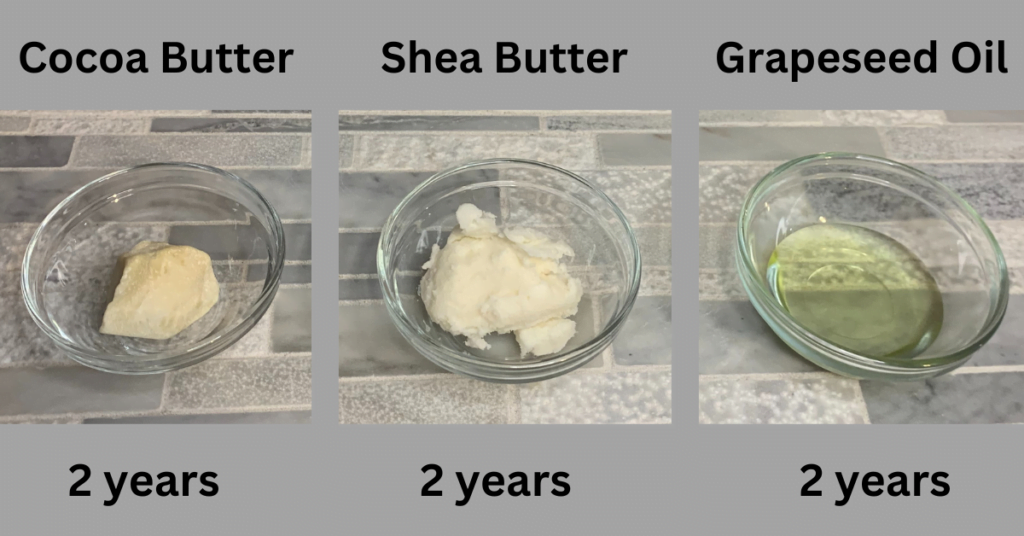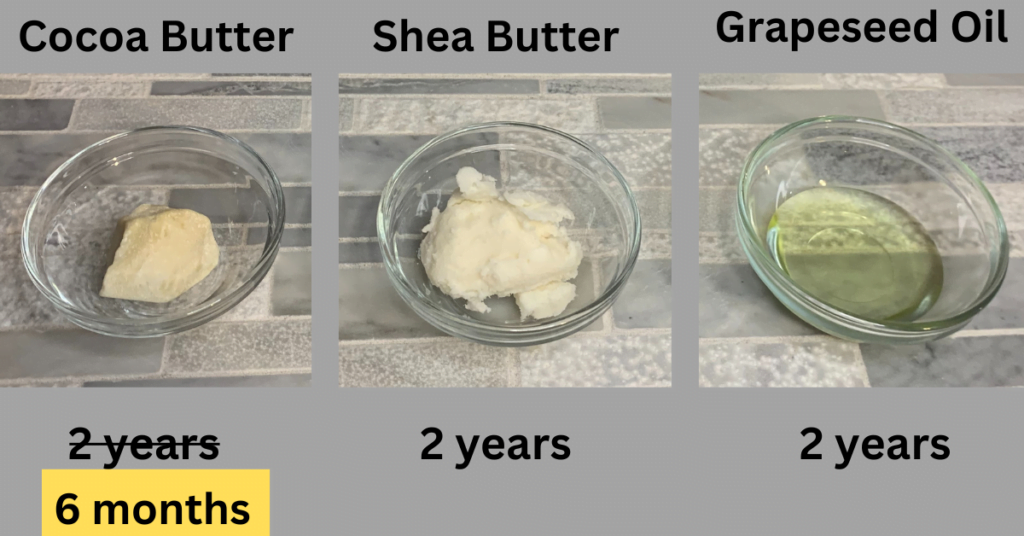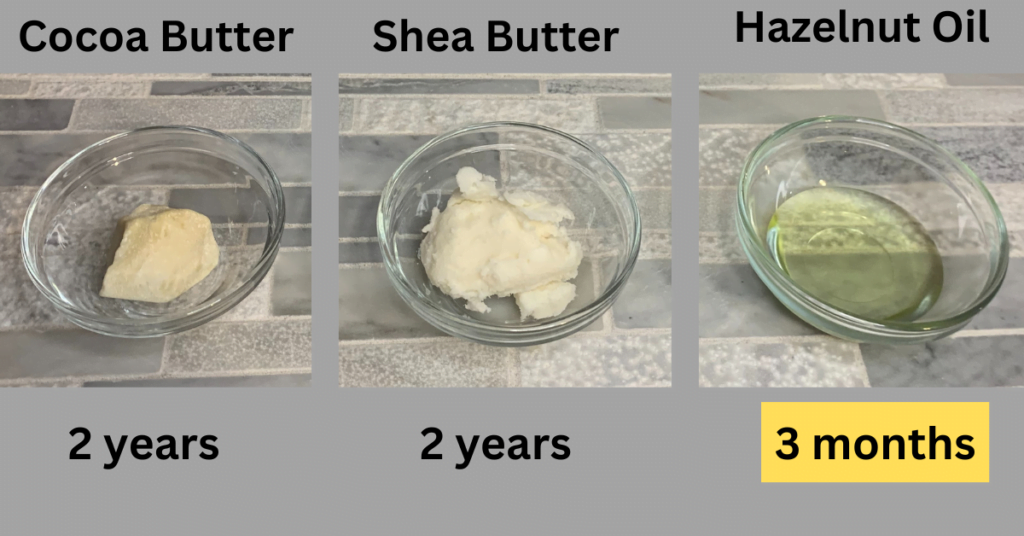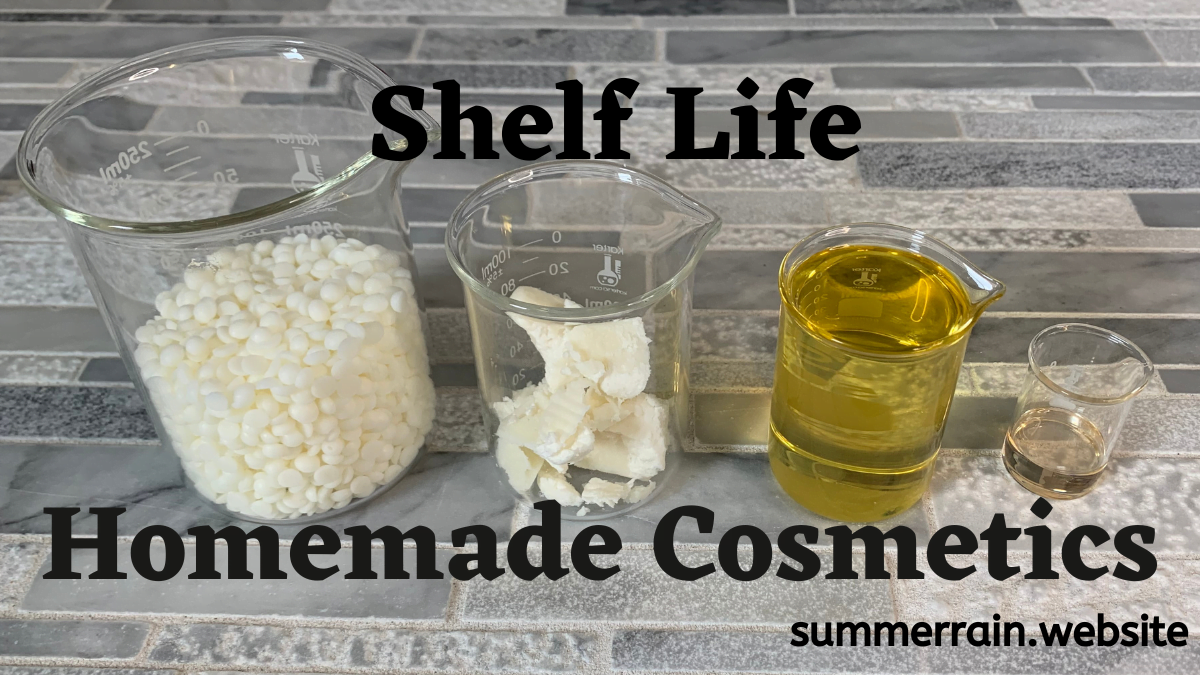The question that I am asked most often is How Do You Determine The Shelf Life of Homemade Cosmetics. Nothing lasts forever, including the cosmetics and skin care that you are making. How long do they last? I am going to walk you through how you can determine the shelf life of your homemade cosmetics and body care products. You need to know this whether you are making the products for yourself, friends or selling them. The last thing you want to do is give someone a product that will be unsafe to use.
To start, it is not super difficult to get an approximate shelf life of your homemade products. You just need a little bit of information. Also, there are things that you can do, to extend the shelf life of your products.
Table of Contents
Prefer to watch this project instead of reading it?
Some of the links are affiliate links, because I am an associate and I earn a small commission on them.
Do natural skin care products expire? What is shelf life?
The shelf life of your product is how long it will look and behave as you would expect it to and how long until it becomes unfit to be used any more. Take a look at any store bought cosmetics and you will notice they have a shelf life on them. Depending on what the product is, the shelf life will vary.
Some cosmetics have a shorter shelf life
When you are thinking about the shelf life, you also have to consider how and where the product is used. For example, a cosmetic that is used on your eye area will normally have a shorter shelf life than something that you use on your body. Whereas, a soap will often have a shelf life of years due to the high pH level.
How long does homemade skin care last? Approximating Our Products Shelf Life
You will want to look at the shelf life of each ingredient. Now, this can be kind of difficult depending on how many ingredients you are using. The trick is to find the ingredient with the shortest shelf life.
The rule of thumb is a product is only good as long as the one with the shortest shelf life.
When I buy a product, I will put a label on the container so I know when I opened it and what that ingredient’s shelf life is. This takes a lot of the work out of figuring out how long a product will last.
Variables
There are variables that will have an effect on the shelf life of the products you are making.
- Disinfecting: It is super important that you are disinfecting and keeping a clean work area and equipment. The reason it is so important is that we do not want to do anything to introduce bacteria into our products.
- Preservatives: Equally important is using a preservative when one is needed. Typically you should use a preservative anytime you use water or water may be introduced into a product. This means that you would use a preservative in a container where you would use wet hands to scoop the product out.
- Containers: You might be thinking, how does the container I use matter? Well it does. For example, a product that is in a container that you dip your fingers into is not going to last as long as a product that has a pump top. This is because each time you dip your fingers into it, it is introducing bacteria and fungi into the product. A conditioner that is in a bottle is going to last longer than one that you dip your hands into.
- Emulsions: Anytime you have an emulsion, it is just a matter of time before the water and oil separate. It can easily be prolonged, but the separation is inevitable. You can read more on emulsions here.
Watch For Signs
One of the most important things that you need to know when making your own skin care is the finished product’s shelf life.
Why does shelf life matter?
Safety
- You always want to ensure that the products you are putting on your skin are safe to use. You don’t want to use anything that might have mold or bacteria growth in it.
- And you don’t want to sell or give away anything that’s not safe to use.
Container Size
- Knowing the shelf life of your products is going to guide you to the type and size of container you should use.
- If you have a serum that has a 3 month shelf life, you will probably make this in relatively small amounts, an ounce or less.
- On the flip side, if I know my lotion has a shelf life of a year, I would feel comfortable making 2 or 3 – 8 ounce bottles at a time, because I know that I will be able to use it before it goes bad.
Container Type
- The type of product and shelf life can help you choose an appropriate container.
- If you have a product that wet hands might get dipped into, it might make sense to use a container with a pump.
- If you have a product that is stored in the shower, you want to make sure water cannot get into the finished product by using a pump or flip lid.
How to Estimate the Shelf Life of Homemade Cosmetics
To estimate the shelf life of your oil only product, you have to determine the oil with the shortest shelf life. Here is an example from my whipped body butter:
Whipped Body Butter Shelf Life – Example 1

The shelf life would be 2 years because that is the shortest shelf life of my oils.
Whipped Body Butter Shelf Life – Example 2
Let’s say we are making the same Whipped Body Butter with the same ingredients. The only difference is that the cocoa butter was opened 18 months ago. This would mean that the shelf life of the ingredient is now 6 months because the shelf life starts when you open the product.

Whipped Body Butter Shelf Life – Example 3
You will notice that I selected oils that have a relatively long shelf life. Personally, I wouldn’t use oil that only had a 3 month window (such as hazelnut oil). Let’s look at what the shelf life would be if we did use Hazelnut Oil.
In this example, the Whipped Body Butter would only have a shelf life of 3 months.

Oil Only Products
Oil only products would be those products that do not contain any water. An example would be Whipped Body Butter , Lotion Bars and DIY Lip Balm.
The cool thing about these types of products is that there is no need for a preservative. There is not a risk that the product is going to grow mold.
The main concern with oil products will be with the oils going rancid. All oils at some point will go rancid. This is caused by a reaction that happens when oils are exposed to air, causing oxidation.
Products with Water
Do I need a preservative in homemade lotion?
Any products where you add water or hydrosols to, will require a preservative. Really, the minute you add water you know that you need a preservative to prevent growing mold and bacteria.
Without a preservative, you might be able to use it for up to 3 days before it starts growing some pretty nasty stuff. I have seen people who will store their homemade products in the fridge. (Is it just me, or wouldn’t it be a little weird to put on lotion from the fridge?) The fridge will be able to keep your products another day or two, but that’s it.
Adding a preservative will extend the life of these products and they do not have to be stored in the fridge.
Estimating the shelf life when preservative is used
The process of estimating the shelf life is the same as you did with the oil only product. The main difference is that you have more ingredients to consider. Here is an example from my Aloe Vera Lotion:
Olive Oil- 2 years
Macadamia Nut Oil – 2 years
Cocoa Butter – 2 years
Aloe Vera 10X Concentrated – 1 year
The shelf life would be 1 year, because the Aloe that we use has a 1 year shelf life. Even though all of my oils are still good for another year, my aloe has a shorter shelf life and it will expire first. (This is assuming that I just opened all of these ingredients. If they have been opened earlier, you would need to take that into account.)
So even though we know an estimated shelf life of our products that does not mean that shelf life is guaranteed. You should always keep an eye on your products to make sure that they are not going bad.
Things to watch for
- Change in consistency
- Getting watery or thinning out
- Change in color
- You notice that it is starting to look brown or yellow.
- Change in smell
- You notice that the product does not smell like it used to.
If you notice any change in your products, air on the side of caution and toss them out!
Things you can when making skin care to extend the shelf life of homemade cosmetics:
Sanitizing
Before you even start making your products, it is essential that you are sanitizing everything. Your work area, your equipment and bottles. This is to ensure that you’re not putting your beautiful creations into an already contaminated container or mixing it with an un-sanitized spoon.
Wear Gloves
As often as you can, you should wear gloves when making your products to prevent any bacteria or germs from getting into the product from your hands.
Distilled Water
Using distilled water reduces the risk of adding in any contaminants into your product.
Tips to Extend Shelf Life of Homemade Cosmetics
Vitamin E Oil
Vitamin E Oil can be used to help to slow down the oxidation process and extend the time before the oils go rancid. Which is great, but it is important to note that it is not a preservative.
Avoid Weird Ingredients
Avoid using ingredients that are going to be difficult, if not impossible to preserve. (Such as fresh fruit or yogurt).
Container
The type of container that you use will have an effect on the shelf life of your product. Any time you use a container where you dip your fingers into it, it is going to reduce the shelf life, because you are making it more susceptible to unwanted growth. Using something to scoop the product out of the container, would extend the shelf life.
